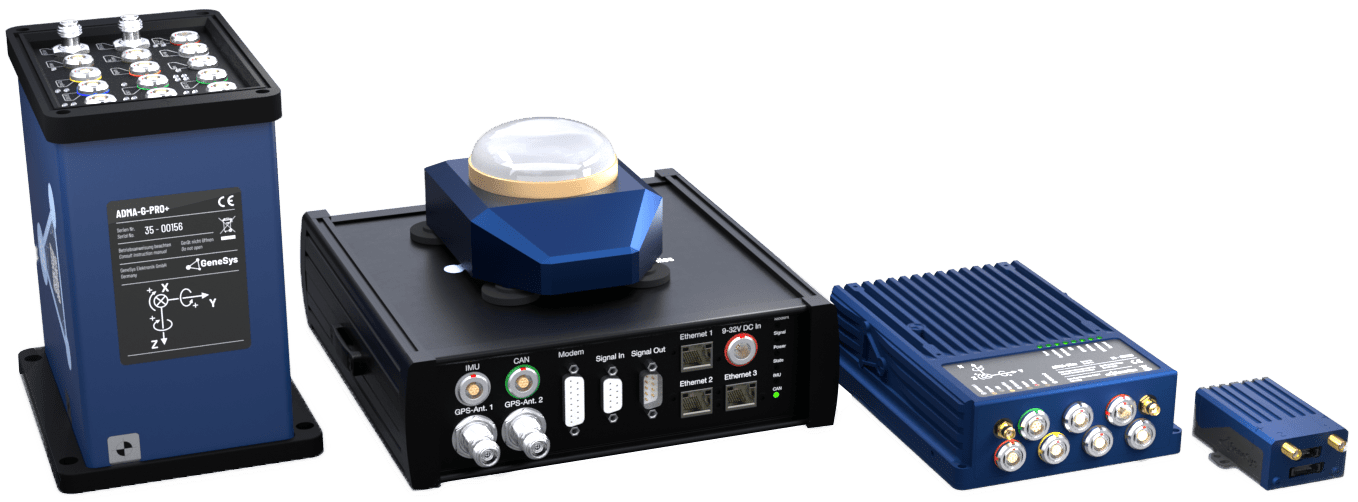The GNSS-aided inertial system ADMA from GeneSys was developed specifically for vehicle dynamics testing and ADAS evaluation in the automotive industries. The high-precision inertial measurement unit (IMU) provides reliable position and motion data of a vehicle “live” and without drift when the vehicle is stationary. The device is quickly and easily configured via web browser. Thanks to the fastest initialization in its category, the ADMA is ready for operation in just a few minutes. Users benefit from more than 20 years of application know-how and the experience of the GeneSys experts. Customer-oriented and dedicated support completes the overall package for measuring & testing with the ADMA.
The Automotive Dynamic Motion Analyzer, ADMA for short, permits high-precision dynamic measurements of all motion states such as acceleration, speed, position, rotational speed, orientation, and sideslip angle of the vehicle.
Fastest initialization
Due to its extremely precise inertial sensors, commissioning and initialization of the ADMA can be performed in just a few minutes. Once the antenna has been mounted on the vehicle roof, the ADMA is installed in the vehicle and the cables are connected, the configuration is quickly completed via the built-in web interface. Finally, only a very short initialization run is required. During the initialization run, the current transient state of the Kalman filter can be conveniently displayed in the ADMA Ethernet logger or in any data acquisition system. Maximum performance of the inertial components in the ADMA is achieved with full initialization. Major advantage: Once set up and configured, no further handling is necessary! This makes it the fastest initialization in its category.
No drift while stationary
Another challenge is to master the sensor drifts of the IMU, especially when the vehicle is stationary. Due to the high-quality sensors installed in the ADMA and intelligent signal processing algorithms, the vehicle standstill can be detected reliably, and the sensor drift is compensated perfectly. In other words: No matter whether the vehicle is moving or stationary, vehicle movements are always recorded with the highest precision. This eliminates the need for regular re-initialization, known from conventional systems, and results in a significant increase in availability.
High data rate and low data latency
The device generation ADMA 3.0 is equipped with many functions. One of them is the output rate of 1000 Hz with unlimited data set and a data latency of less than 1 millisecond! In practice, such high real-time data rates prove to be particularly valuable in the field of driver assistance development. For example, if a vehicle is moving at 100 km/h, the position can be resolved to less than 2 cm.
Besides CAN bus interfaces, the device also includes Ethernet interfaces for data output, configuration and driving robots. An interface for connecting a so-called “Indoor Positioning System” (IPS) is already prepared. IPS enables indoor driving tests to be carried out to the centimeter under reproducible environmental conditions.
Applications
The GNSS-aided inertial system ADMA is used by customers for a wide application range, such as vehicle dynamics testing, brake and acceleration measurements, chassis tuning, tyre testing, driving comfort analysis, road surveying, validation of simulation models, navigation of driving robots, validation of driver assistance systems and development of highly automated driving functions.
Conclusion
Besides vehicle dynamics testing, the ADMA is the first choice for the evaluation of driver assistance systems such as ACC, FCW, AEB, and LDW. The GNSS-aided inertial system meets all requirements of the international test standards.
Visit us at the following trade fairs or simply call us for more information.
GeneSys Elektronik GmbH
- Safety Expo Wuerzburg, Stand 1+2
- AUTOMOTIVE TESTING EXPO EUROPE 2020, Stuttgart, Stand 8314
- Chassis.tech plus, Munich, Stand 12
- PraxisConference Safety Assist
- Messtec + sensor masters, Stuttgart, Stand 4D





